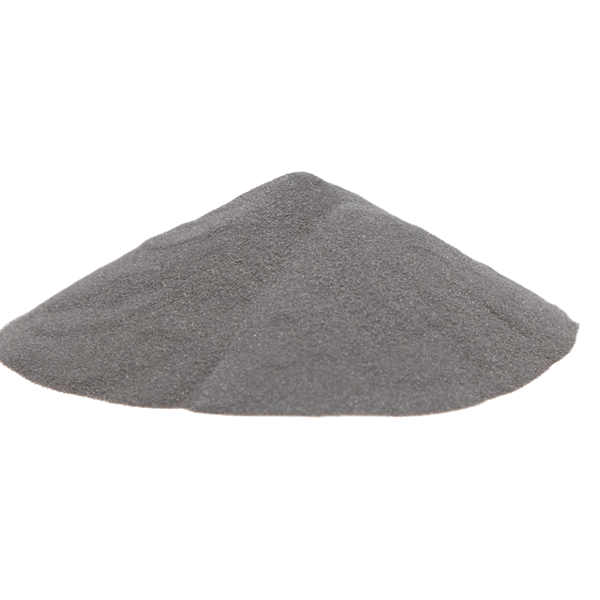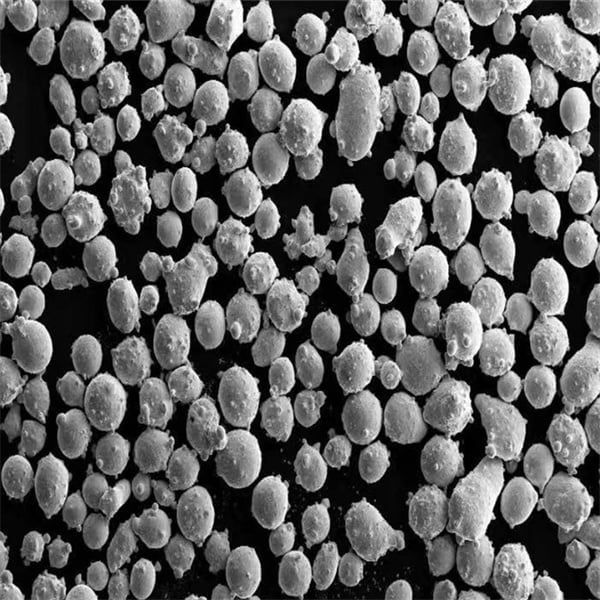3D-utskrift av kopparpulver
Innehållsförteckning
Översikt över 3D-utskrift av kopparpulver
Kopparpulver för 3D-utskrift är ett metallpulver tillverkat av ren koppar eller kopparlegeringar som används som råmaterial i olika 3D-utskriftstekniker för tillverkning av slutanvändningsdelar och produkter i koppar.
Några viktiga egenskaper och fördelar med att använda 3D-utskrift med kopparpulver inkluderar:
- Hög elektrisk och termisk ledningsförmåga önskas för elektronikapplikationer
- Mycket hög maskinbearbetningsgrad för bra finish och efterbearbetning
- Utmärkta mekaniska egenskaper som hållfasthet och duktilitet
- Korrosionsbeständighet tack vare bildandet av ett skyddande kopparoxidskikt
- Biokompatibel för medicintekniska produkter och implantat
- Kostnadsfördel jämfört med konventionell bearbetning av koppar
Flera 3D-utskriftsprocesser för metall använder kopparpulver, oftast:
Olika typer av 3D-utskrifter med kopparpulver
| 3D-utskriftsteknik | Beskrivning |
|---|---|
| Binder Jetting | Limmar kopparpulver med hjälp av flytande bindemedel |
| Deposition med riktad energi (DED) | Använder laser eller elektronstråle för att smälta kopparpulver |
| Selektiv lasersmältning (SLM) | Selektiv lasersmältning och smältning av kopparpulverbädd |
Dessa additiva tillverkningstekniker gör det möjligt att skapa komplexa geometrier med koppar som inte kan gjutas eller bearbetas. Delar kan tillverkas på begäran utan verktyg eller formar.
Låt oss nu ta en djupare titt på kopparkvaliteter för 3D-utskrift, egenskaper, applikationer, specifikationer, prissättning, jämförelser och mer.

Sammansättning av 3D-utskrift av kopparpulver
Det finns några huvudtyper av kopparmetallpulver som används vid additiv tillverkning:
Sammansättningar av kopparpulver för 3D-utskrift
| Typ av pulver | Typisk sammansättning |
|---|---|
| Ren koppar | 99,7% Cu minimum |
| Koppar-tenn-legering | Cu-10Sn bronslegering |
| Koppar-nickel-legering | 90Cu-10Ni eller 70Cu-30Ni |
Egenskaper hos 3D-utskrivna delar av ren koppar
- Utmärkt elektrisk ledningsförmåga för elektronik
- Duktilt material som möjliggör efterbearbetning
- Glödgning kan ytterligare förbättra duktiliteten
- Låg hårdhet vid 100 HV efter tryckning
Proffs
- Högsta termiska och elektriska ledningsförmåga
- Lätt att bearbeta, plåta och ytbehandla efter byggnation
- Biokompatibel för medicinsk användning
- Svetsning av olika metaller förenklas
Nackdelar
- Mjuka texturer och funktioner med låg hållfasthet
- Risk för delaminering mellan skikten
- Oxidfilmsbildning som är känslig för kontaminering
Egenskaper hos 3D-utskrivna Cu-Sn-bronsdelar
- Bättre mekaniska egenskaper med tennlegering
- Upp till dubbelt så hög hårdhet och styrka
- Slitstark ytfinish för rörelse
- Högre temperaturbeständighet
Proffs
- Starkare delar för att motstå deformation
- Gör det möjligt att skriva ut fina detaljer och texturer
- Små mängder tenn förbättrar egenskaperna
- God korrosionsbeständighet
Nackdelar
- Lägre termisk och elektrisk ledningsförmåga
- Högre densitet ökar vikten
- Behöver fortfarande stöd vid utskrift
Egenskaper hos 3D-utskrivna delar av Cu-Ni-legering
- Utmärkt kombination av styrka och ledningsförmåga
- Bibehåller hög duktilitet och termiska egenskaper
- Tillför hårdhet för slitageskydd
- Lödar bra med andra kopparkomponenter
Proffs
- Avstämbara egenskaper som balanserar styrka, hårdhet och ledningsförmåga
- Starka delar som kan motstå påfrestningar
- Bara 10% nickel fördubblar sträckgränsen
- Lägre smältpunkt ger tryckning vid lägre temperaturer
Nackdelar
- Inte biokompatibel för medicintekniska produkter
- Nickel kan initiera galvanisk korrosion
- Högre materialkostnader än ren koppar
Användningsområden för 3D-printad koppar
Tack vare sina mångsidiga materialegenskaper används 3D-utskrifter med kopparpulver i många olika branscher:
Tillämpningar av kopparpulver för 3D-utskrift
| Industri | Vanliga tillämpningar |
|---|---|
| Elektronik | Kopplingar, kontakter, plintar, EMI-skärmning |
| Elektrisk | Samlingsskenor, rotorlindningar, elektromagneter |
| Värmeväxlare | Kylflänsar, förångare, kondensorer |
| Fordon | Svetstips, bussningar, lager |
| Arkitektur | Dekorativa fasader, paneler, modellering |
| Medicinsk | Elektroder,GREENs, implantat, kirurgiska verktyg |
Några exempel på specifika produkter är
Elektronik: Ledande spår, kablar, antenner, batterier, sensorer
Fordon: Lamphus, snabbkopplingar, gängade insatser
Aerospace: Fästen, komponenter för vridmomentkontroll, radiohårdvara
Konsumentvaror: Knappar, förslutningar, blixtlås, dekorativa delar
Hårdvara: Kugghjul, lås, fjädrar, fästelement som muttrar och bultar
Genom att utnyttja kopparens egenskaper vid 3D-printing kan man skapa innovativa geometrier som är omöjliga med subtraktiva metoder och som kan förbättra funktionaliteten och effektiviteten.
Specifikationer för kopparmetallpulver för 3D-utskrift
Tillverkare av 3D-skrivare karakteriserar kopparpulver baserat på mätvärden som:
Specifikationer för kopparpulver för 3D-utskrift
| Parameter | Typiskt specifikationsområde |
|---|---|
| Pulverform | Övervägande sfärisk |
| Storleksintervall | 15-45 mikrometer |
| Min skenbar densitet | 3,5 g/cm3 |
| Typisk skikttjocklek | 20-100 mikrometer |
| Flödeshastighet | >=25 sekunder för 50 g |
| Resterande syre | 0,3% max |
Andra viktiga pulvermätningar:
- Tappdensitet: Efter sedimentering varierar mellan 4-4,5 g/cm3
- Hall flödeshastighet: Tid för 50 g pulver att rinna genom trattens öppning
- Hausner-kvot: Tappdensitet dividerad med skenbar densitet indikerar flytbarhet
Smal fördelning ger tät och jämn spridning av pulvret under tryckningen. Låg syrehalt förhindrar överskott av oxider som försvårar skiktbindningen.
Priser, leverantörer och jämförelser för kopparmetallpulver
Kostnaderna för kopparpulver varierar beroende på marknadspriser, sammansättning, kvantitet och varifrån pulvret kommer:
Kostnadsjämförelse för kopparpulver
| Typ | Genomsnittligt prisintervall | Viktiga leverantörer |
|---|---|---|
| Ren koppar | $50-80 per kg | AP&C, Sandvik Osprey, Carpenter Additive |
| Cu-10Sn brons | $55-90 per kg | ECKA Granules, BASF Additive Mfg, LPW Technology |
| CuNi10-legering | $65-105 per kg | Linde, Arconic Components, Praxair |
Att köpa hög renhetsgrad från certifierade metallpulvertillverkare säkerställer tillförlitlig kvalitet. Utländska leverantörer erbjuder lägre kostnadsalternativ men kan sakna konsekvens.
När du jämför material för kopparpulver för ett utskriftsjobb, tänk på:
För- och nackdelar med olika kopparpulver
| Typ | Proffs | Nackdelar |
|---|---|---|
| Ren koppar | Högsta termiska/elektriska prestanda<br>Lägsta kostnad | Mjuka delar som är benägna att slitas<br>Risk för delaminering |
| Cu-bronslegering | Starkare komponenter<br>Bättre upplösning för fina detaljer | Tyngre komponenter<br>Lägre ledningsförmåga |
| Koppar-nickel | Balanserad styrka plus ledningsförmåga <br>Kontrollerad friktion/slitage | Ej biokompatibel<br>Svårare att bearbeta |
Sammanfattningsvisren koppar passar elektronikens behov med betoning på ledningsförmåga och duktilitet till låg kostnad, medan legeringar bättre uppfyller mekaniska krav med högre hållfasthet och hårdhet.
Parametrar, tröskelvärden och rekommendationer för tryckning
Att välja optimala utskriftsinställningar är nyckeln till framgångsrik användning av kopparpulver:
Inställningar för utskriftsprofil för kopparpulver
| Parameter | Typiskt intervall | Rekommendationer |
|---|---|---|
| Skiktets tjocklek | 20-100 mikrometer | Tunnare lager förbättrar bindningen mellan lagren |
| Lasereffekt (för SLM) | 100-500 W | Högre densitet och vätning vid ökad effekt |
| Skanningshastighet | 100-500 mm/s | Snabbare hastigheter minskar värmetillförseln och restspänningen |
| Strålens storlek | 20-100 mikrometer | Laserdiameter nära skikttjockleken |
| Stödstrukturer | Trädliknande | Förhindra skevhet och avlägsna sedan genom efterbearbetning |
| Skärmande gas | Argon eller kväve | Förhindra oxidation under byggtiden |
| Uppvärmning av byggplatta | 50-250°C | Kylfläns en gång avsatt om kylningen är för snabb |
| Stresslindring | Glödgning 1-3 timmar vid 400°C | Minskar restspänningar och främjar skiktets integritet |
| Varm isostatisk pressning | 1000-10000 psi vid 500-950°C | Öka densiteten genom att kollapsa hålrum |
| Ytbehandling | Trumling, maskinbearbetning, slipning, polering etc. | Utjämna ytjämnhet |
Övervakning av smältbadets storlek och temperaturer underlättar kalibrering av laserparametrar i realtid. Anpassa energitillförseln till tryckområdet för att uppnå god fusion utan överdriven uppvärmning.
För delar av hög kvalitetTermisk hantering är nyckeln tillsammans med att minska restspänningen genom strategiska uppvärmnings- / kylcykler under utskrift samt värmebehandlingar efter byggandet. Utnyttja standardmetoder för metallbearbetning/maskinbearbetning för efterbehandling av koppartryckta komponenter.
Branschstandarder för 3D-utskrift med metallpulver
Standardiseringsorganisationer för additiv tillverkning av metall
| Organisation | Relevanta AM-standarder för metall |
|---|---|
| ASTM International | F3049, F2971, F3184, F3301 etc. för legeringar, processkrav, kvaliteter |
| Internationella standardiseringsorganisationen (ISO) | ISO/ASTM 52915, 52921 som omfattar konstruktion, processer, testning |
| SAE International | AMS7001A Material- och processpecifikationer för flyg- och rymdindustrin |
| Amerikanska föreningen för mekaniska ingenjörer (ASME) | BPVC Sektion IX Svetsningskoder |
| Nationella institutet för standarder och teknik (NIST) | Referens koppar pulverdata och mätvetenskap |
| Internationella elektrotekniska kommissionen (IEC) | IEC 62890 benchmarking av metallpulverbäddfusionsprocessens prestanda |
Dessa delar med sig av bästa praxis och kvantifierar repeterbara prestandakriterier för att kvalificera delar för slutanvändning.
För komponenter för flyg- och rymdindustrinDessutom måste ytterligare CAA- och FAA-standarder uppfyllas. Fordon delar hänvisar också till UL-, AQLA- och NADCAP-specifikationer.
I applikationer för medicintekniska produkterFör att säkerställa biokompatibilitet och patientsäkerhet är det obligatoriskt att uppfylla FDA- och CE-bestämmelserna före kommersialisering.
Sammantaget synkroniserar standarderna teknikutvecklingen inom hela industrin för additiv tillverkning av metall.

Vanliga frågor
F: Hur väljer jag rätt kopparlegering för min applikation?
S: De flesta produkter betonar antingen styrka, hårdhet och slitstyrka eller termisk/elektrisk ledningsförmåga. Genom att anpassa legeringselementen, t.ex. tenn eller nickel, kan man optimera de olika egenskaperna.
F: Kräver kopparpulver skydd av inert gas vid tryckning?
S: Ja, uppvärmning av kopparpulver till höga temperaturer orsakar ytoxidation som förlorar legeringselement. Skärmning med argon eller kväve förhindrar alltför stor materialförlust.
F: Vad orsakar sprickbildning mellan lager vid 3d-utskrift av koppar?
S: Olika kylhastigheter och krympning av legeringar kan ge upphov till spänningar som leder till sprickor mellan lagren. Bättre värmekontroll under tillverkningen och spänningsavlastande värmebehandlingar efter processen minskar dessa defekter.
F: Varför har min 3d-utskrivna koppardel dålig ytfinish och textur?
A: Otillräcklig smältning av pulverpartiklar från låg lasereffekt orsakar porösa ojämna texturer som kräver omfattande finishbearbetning. Tryckkalibrering, tillräcklig skiktöverlappning och högre energitäthet förbättrar ytkvaliteten.
F: Är direkt metalltryck med kopparpulver mycket dyrt?
S: Ja, båda skrivarsystemkostnaderna på över $100.000 plus återkommande inköp av metallpulver gör det oöverkomligt dyrt för små produktioner. Kostnaden per del sjunker dock avsevärt för volymproduktionskörningar på grund av inga verktygskrav.
Dela på
MET3DP Technology Co, LTD är en ledande leverantör av lösningar för additiv tillverkning med huvudkontor i Qingdao, Kina. Vårt företag är specialiserat på 3D-utskriftsutrustning och högpresterande metallpulver för industriella tillämpningar.
Förfrågan för att få bästa pris och anpassad lösning för ditt företag!
Relaterade artiklar

Högpresterande segment för munstycksvingar: Revolutionerande turbineffektivitet med 3D-utskrift i metall
Läs mer "Om Met3DP
Senaste uppdateringen
Vår produkt
KONTAKTA OSS
Har du några frågor? Skicka oss meddelande nu! Vi kommer att betjäna din begäran med ett helt team efter att ha fått ditt meddelande.

Metallpulver för 3D-printing och additiv tillverkning
FÖRETAG
PRODUKT
cONTACT INFO
- Qingdao City, Shandong, Kina
- [email protected]
- [email protected]
- +86 19116340731
















